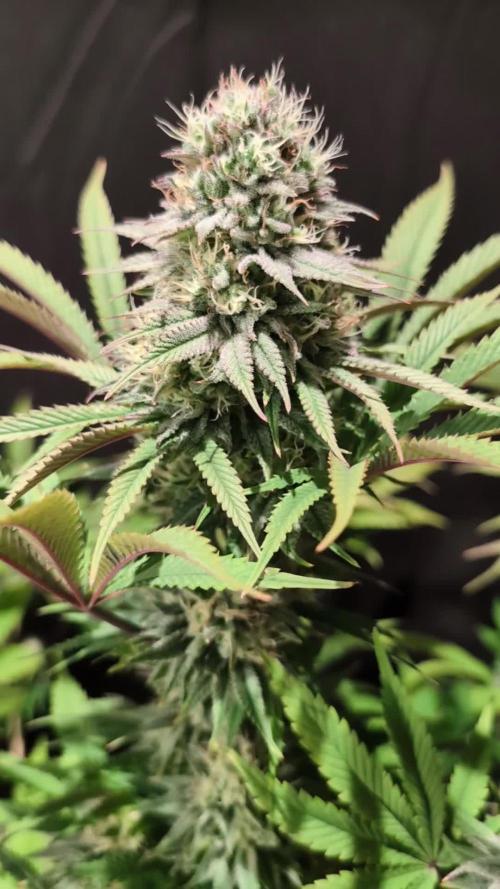The Grow Awards 2026 🏆 





































Likes
Comments
Share


@BloodBath
Follow
Just checking trichomes at this point. Only feeding water for remaining time left before she gets chopped, dried, and cured. One more month and she will be tasty af.
Likes
14
Share


@OutdoorUK
Follow
Been busy so didn’t get any photos of just before it went in flower but here’s where we are up to
Likes
21
Share


@JuicyFruit
Follow
End of week 5 - Night 41
Added a couple videos, one from the side of the buds and one from the back (LST)
things are going well for this plant now, it may only be 15-18cm but its flowering stronger than my other plants. the smell is just getting more pure and strong every day :) and its getting frostier too :D so excited!
I have to grab myself a magnifying glass of sorts on monday to try and estimate when harvest will be :o
Likes
9
Share


@bigolebuds
Follow
Week 8 Day 1: how did we get here?! Northern Lights is looking beautiful (the only plant in a 5 gal pot outside). No major issues. Kids were fed liquid nutrients for the second time 9/8, and will be recieving them once a week moving forward (hopefully every other watering). Gotta find a way to make watering a smoother process tho, might invest in a home RO filter 😂 Big dreams being discussed, this could be the start of the only cultivation, breeding, and distribution center that has a primary focus on re-entry and subsequent business development.. That’s how you do socially responsible business and policy.
You heard me?
Likes
4
Share


@Reisi
Follow
Bilder von Blütetag 28. An manchen Tagen trinkt sie jetzt 4 Liter Wasser. Wunderschöne Pflanzen 😍
Likes
19
Share


@mi_auto_grower
Follow
I sat this one out side just to blow up with sun light for the last two-three weeks that it has left
Likes
104
Share


@Wastent91
Follow
Eccoci alla fine è andato tutto secondo i piani, la ragazza aveva però gli steli un po esili rispetto all enorme peso portato dalle cime fresche in fioritura, ho provveduto a legarle tutte a dei sostegni, xke erano davvero molto pesanti 750 grammi di pianta è davvero un bel raccolto! Per il resto è venuta davvero una ragazza con dei colori finali stupendi, cime dure come roccia, non stracolma di resina come le altre sorelle del box ma nel complesso sono molto soddisfatto! Grazie Barney per avermi dato la possibilità di provare questa fantastica genetica! E grazie a tutti voi che mi seguite e a selena di Mars y che ha fiducia nel mio lavoro! Un bacio a tutti! Non vedo l ora di fumare! 😁💪😸🌱🌲💐🧑🌾
Likes
3
Share


@GrowinHome
Follow
Its been a while but the ladies are still doing fine.
After today its gonna be lights out.
Ive stopped giving nutrients about 10 days ago.
Likes
12
Share


@w33dhawk
Follow
Die Woche ist gut verlaufen, alle samen aufgeploppt und sind gut am wachsen
Likes
23
Share


@MaltaHerbman
Follow
First 7 days of the Strawberry Gorilla from Fastbuds.
She was germination in glass of water than move to cotton and in 2 days it had more than an inch of root so i moved to her home 12 liters pot with biobizz,coco peat and perlite for the vegitation she will have the Marshydro Ts 600 in 80 x80 grow tent.
Likes
2
Share


@vooodi
Follow
В конце этой недели я снял урожай, но сделал это вынуждено.
Верхние бутоны начали вянуть (1 фото), в отличии от остального растения, здесь я заподозрил неладное... Я насильно раздвинул верхний цветок и получил психологическую травму 😢
Так как самые верха уже были размером с кулак и очень плотные,- внутри они не проветривались, там скопилась влага и завелась плесень 😭😭😭
Это выглядело ужасно!!! Настолько, что я даже не стал делать фото.
Почти все прекрасные верха пошли на выброс. Слава джа, что я заметил это не слишком поздно и плесень была только в самых плотных шишках на самом верху растения.
Я самым тщательным образом осмотрел каждую срезанную шишку, порезал на части чтобы рассмотреть все изнутри.
И в результате пришлось выкинуть 83 гр самых смолянистых цветов, самых кайфовых 😓
Еще я не подумал о том, что мелко порубленные шишки, без стеблей, высохнут быстрей чем обычно.
Итого я получил 115 гр сухих (пересушенных) цветов.
После харва разрезал корневую из любопытства, оцените и вы на фото.
Друзья, учитесь на моем опыте - следите за обдувом растения!
И если у вас крупные и плотные соцветия - не бойтесь их тревожить и тщательно осматривайте шишки внутри, вплоть до стебля.
Ну и в финале из этого растения родился ганджа-жук, защитник кустов от всевозможных вредителей 👽 (видео)
Likes
6
Share


@Purrple_Haze
Follow
Topped & Sun-Kissed ☀️✂️
This week, I finally made the call—she’s been topped! 🌿
After a bit of back and forth, I decided it was time to give her structure a little boost and open things up to more sunlight. The side shoots are now reaching out confidently, soaking up every bit of that warm summer glow. ☀️
She’s had a golden week of sunshine and handled it like a champ—strong, vibrant growth and no signs of stress post-topping. 💪
Here’s what went into her care routine this week:
🔸 Fed with BioBizz Grow, CalMag and Alg-a-Mic
🔸 Followed by some homebrewed compost tea two days later for that microbial boost
🔸 Two days after that, a fresh round of Effective Microorganisms to enrich the soil life
🔸 And every 3 days, a light misting of silica spray to keep her leaves strong and resilient
I’m super happy with how she’s shaping up so far—great energy, lush color, and the new growth is coming in fast. Curious to see how she responds to the topping in the next week!
Likes
85
Share


@Grey_Wolf
Follow
Peyote Wifi Super soil diary update 30th Jan 2020
Guess what peoples ... My Peyote Wifi is in Bloom Baby!!! Only took 4 months to get here 😁 We have rain forecast here for the next few days so whilst it's cooler I thought
it an excellent time to allow my soil to dry a little. So whilst the rain is hanging around I won't water the plant at all.
Last week I dosed the soil up with the Dr greenthumbs Bud n bloom which should allow immediate access to the P&K this Girls gonna want from now on until harvest.
During the flowering period big plants like this can use up any available nutrients quite quickly so I'll need to reapply the bud n bloom again in about 4 weeks time.
I have been looking at the other Peyote Wifi diaries here on growdiaries and If mine end up looking anything like those buds I will be one very happy Customer.
Some of them look like straight up Fire.
Ph Check up with the bluelab soil probe showed the soil to be at 6.5 and stable.
Thankyou for Reading this latest Update and I shall be back next week. 👍👊👍
Likes
3
Share


@GoodTimesOrganics
Follow
Welcome Back!💚
Die sechste Blütewoche ist vorbei und die Blütenentwicklung kommt langsam an ihren Höhepunkt.
Es zeichnet sich eine schöne, Dichte Blütenstruktur ab, mit immer weiter ansteigendem Trichom Anteil.
Das Aroma nimmt ständig zu und es sind fruchtige und süßliche Aromen wahrnehmbar, allerdings kommt jetzt noch ein tiefer dumpfer Geruch dazu.
Da es aktuell vie Regnet, sind die Werte auch etwas anders. Die Luftfeuchtigkeit ist wieder höher und die Temperatur ging auch etwas rauf.
———————
🌞 Temp: 23°C
🌚 Temp: 20 °C
💨 RH: 58%
VPD: 0,86kPa
😎PPFD: 830 mqm
———————
Stay Tuned! 💚
Likes
9
Share


@newenglandgrowers
Follow
Cut the plants down on the 24th of April, drying room levels are 72°F and around 60%RH, I'm currently on Day #14 of drying and the buds don't feel fully dry yet, the main tops feel crunchy and dry but the lower smaller buds are still quite moist and smell like chlorophyll, I think I may harvest the main tops so I don't overdry and leave the rest in the tent for another few days, either that or put the rest of the buds in a brown paper bag to finish drying. Finished dry trimming the plant ended up with 200 grams dry weight not including trim there's another 2 ounces of trim which if you want to include that would bring the total weight from this 250W LED to 256 grams. I'm super happy with the result of this especially for my first grow and from one autoflower, it can only get better from here on out. FYI Not sure why I can't edit the lights I used but the bloomgro 600W LED is PULLING AN ACTUAL 250W FROM THE WALL so the gram/watt should be .8g/W
Likes
8
Share


@eldruida_lamota
Follow
Que pasa familia, vamos con la décima y última semana de floración de estas Zkittelz de Seeds Mafia.
La humedad está entorno al 50%, y la temperatura la tengo entre los 22/24 grados.
Controlamos en ph en cada riego a 6.2.
Y el agua que utilizo de riego suele estar estancada entre 24 / 36 horas.
Hasta aquí todo bien, las flores ya están maduras y ya es hora de cosechar.
Las flores se ven compactas y bie. Resinosas, dejaré secar una o dos semanas y actualizaremos la smoke review.
Mars hydro:
Code discount: EL420
https://www.mars-hydro.com/
Agrobeta:
https://www.agrobeta.com/agrobetatiendaonline/36-abonos-canamo
Hasta aquí todo, Buenos humos 💨💨💨
Processing
Likes
6
Share


@Fishcake
Follow
Took the advise and up'd the feed also my ph and ec at run off is 5.81 and 244 think it is helping. In 22 l of water I put 10ml grow 15ml bloom 5ml topmax and then 15ml calmag
Processing
Likes
12
Share


@NorCal311
Follow
This grow I am going to do it differently. I am going to do day tracking instead of date tracking.
I am using using pre-grown ( two grows ago) Coco mix with nature suppers soil to experiment with reusing grow medium.
The pots are 5 gallon air pots. I have never used these before so we will see. The 1st take on them that they are very messy compared to fabric pots.
Once established, I will be using half strength Advanced Nutrients for Coco since these are autos.
Day 1 - 3 Seeds soaked overnight and were put directly into the 5 gallon pots. I pre-soaked the Coco with 5ml/gallon Clonex and covered the seeds with a mason jar.
Day 2 - Temp stayed around 78 all day with me going in and out of the tent looking for a sprout. Nothing yet. 😀 Kept the Coco moist under the jar.
Day 3 - Nothing popping
Day 4 - Two have popped.
Day 5 - One did not pop so I put another seed in
Day 6 - The little ones are growing up. It brings a tear to my eye. 😥
Day 7 - The replaced seed looks to be comming up.
Likes
9
Share


@oxieg3ngrows
Follow
Grape soda, tropical punch, and gasoline. These rock hard flowers were some of the prettiest to watch grow I've ever seen.

















